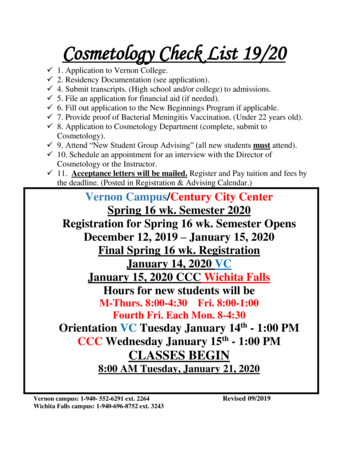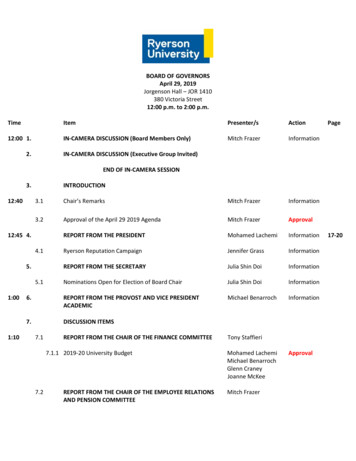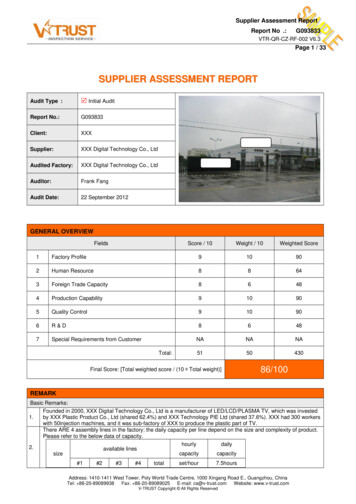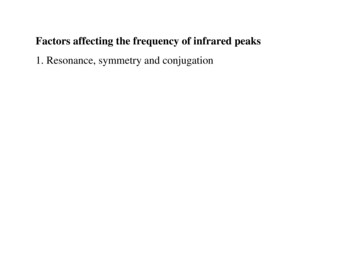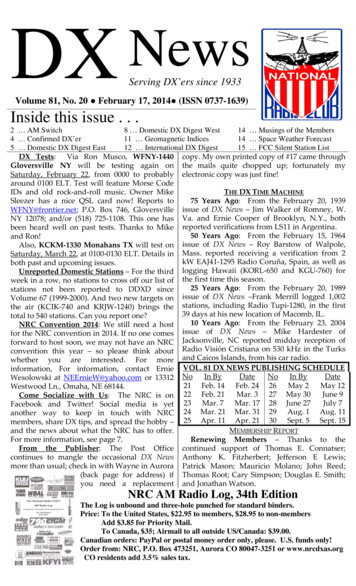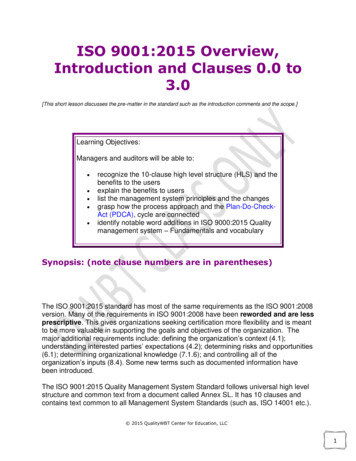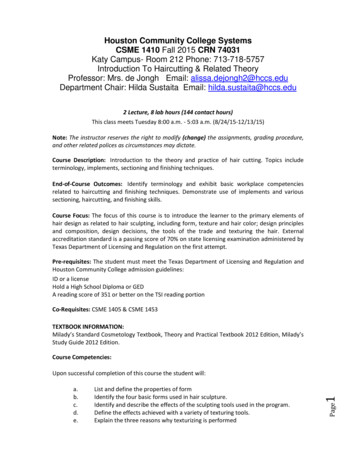
Transcription
Houston Community College SystemsCSME 1410 Fall 2015 CRN 74031Katy Campus- Room 212 Phone: 713-718-5757Introduction To Haircutting & Related TheoryProfessor: Mrs. de Jongh Email: alissa.dejongh2@hccs.eduDepartment Chair: Hilda Sustaita Email: hilda.sustaita@hccs.edu2 Lecture, 8 lab hours (144 contact hours)This class meets Tuesday 8:00 a.m. - 5:03 a.m. (8/24/15-12/13/15)Note: The instructor reserves the right to modify (change) the assignments, grading procedure,and other related polices as circumstances may dictate.Course Description: Introduction to the theory and practice of hair cutting. Topics includeterminology, implements, sectioning and finishing techniques.End-of-Course Outcomes: Identify terminology and exhibit basic workplace competenciesrelated to haircutting and finishing techniques. Demonstrate use of implements and varioussectioning, haircutting, and finishing skills.Course Focus: The focus of this course is to introduce the learner to the primary elements ofhair design as related to hair sculpting, including form, texture and hair color; design principlesand composition, design decisions, the tools of the trade and texturing the hair. Externalaccreditation standard is a passing score of 70% on state licensing examination administered byTexas Department of Licensing and Regulation on the first attempt.Pre-requisites: The student must meet the Texas Department of Licensing and Regulation andHouston Community College admission guidelines:ID or a licenseHold a High School Diploma or GEDA reading score of 351 or better on the TSI reading portionCo-Requisites: CSME 1405 & CSME 1453TEXTBOOK INFORMATION:Milady’s Standard Cosmetology Textbook, Theory and Practical Textbook 2012 Edition, Milady’sStudy Guide 2012 Edition.Course Competencies:List and define the properties of formIdentify the four basic forms used in hair sculpture.Identify and describe the effects of the sculpting tools used in the program.Define the effects achieved with a variety of texturing tools.Explain the three reasons why texturizing is performedPagea.b.c.d.e.1Upon successful completion of this course the student will:
f.g.h.Define the three areas where texturizing is performedDemonstrate sculpting with the following linesa. Horizontalb. Diagonal Rightc. Diagonal LeftDemonstrate the proper technique for shears-over comb sculpting techniqueStudent Learning Outcomes:Upon completion of this course, and given the objectives, guidelines and demonstration by theinstructor, the student will:1.Demonstrate a balanced horizontal solid form hair sculpture, following all safetyand sanitation procedures, within an hour time frame, with a 75% accuracyscore.2.Enhance the horizontal solid form by applying step by step air formingprocedures to style the hair sculpture, observing all safety and sanitationguidelines, within an hour time frame, with a 75% accuracy score.3.Demonstrate the razor arching technique to sculpt a softened horizontal solidform, following all safety and sanitation procedures, within a time frame of 1hour and a 75% accuracy score.The Cosmetology Department does not guarantee that each student will acquire each learningcompetency nor acquire all the hours necessary to complete the program within a specifiedperiod of time. Courses are scheduled at the discretion of the department and are subject totheavailabilityofqualifiedfaculty.STATEMENT OF FOUNDATION SKILLS AND WORKPLACE COMPETENCIES (SCAN SKILLS)A study was conducted for the Department of Labor by the American Society for Training andDevelopment which identified the seven skills United States employers want most in entry levelemployees. These skills are motivation to learn, basic skills, communication, teamwork, criticalthinking, career development and leadership.HCCS is committed to preparing every student with the knowledge and skills needed to succeedin today’s dynamic work environment. Towards this ends, the following skills will be included inthis course. Testing and assessing these skills will vary according to the individual instructor.The following are examples of how these skills may be incorporated into this course.Yes NoYESYESYESYESYES2YESPageSCANS COMPETENCIES ADDRESSED IN THIS COURSE:SCANS MatrixA. Three Part FoundationBasic Skills – Reads, writes, performs arithmetic and mathematical operationsListens and speaksThinking Skills – Thinks creatively, makes decisions, solves problems, visualizes,Knows how to learn and reasonsPersonal Qualities – Displays responsibility, self-esteem, sociability, self-managementAnd integrity and honestyB. Five Workplace CompetenciesResources – Identifies, organizes, plans and allocates resourcesInterpersonal – Works with others, , participates as a team member, teaches work-
related contentInformation – Acquires and uses and evaluates relevant information ISystems – Understands complex inter-relationshipsTechnology – Works with a variety of technologiesYESYESYESGRADE DETERMINATION:Unit Exams10%Mid Term20%Attendance40%Final Project10%Final Exam20%GRADE RANGE:90-100A80-89B70-79C60-69DBelow 60, student will repeat the course.WITHDRAWALS:It is the responsibility of the student to withdraw officially from a course to keep from receivingan “F” for the class.DRESS CODE:Students in the cosmetology operator candidate program are expected to be self-motivatedindividuals and to stay on task at all times. Students must be dressed professionally andappropriately in accordance with the department dress code.PageSCHOLASTIC DISHONESTY AND CLASSROOM CONDUCT:Students are expected to conduct themselves with honor and integrity in fulfilling the courserequirements. Any student found cheating on a test, plagiarizing or in collusion will receive an3Dress Code is as follows for both male and female: Black medical type scrubs (cotton), blackshoes (nursing type) no sandals or backless shoes nor boots. Hose or socks must be worn. Menshould dress accordingly – there should be no sagging scrub bottoms. (Undershirts black)STUDENTS WHO ARE NOT IN PROPER UNIFORM WILL BE ASKED TO LEAVE –AND ABLE TORETURN IN PORPER ATTIRE
“F” for the program. See student handbook for college policy on academic dishonesty, anddisciplinary problems. Any student that is disruptive or disrespectful will be dismissed from theprogram. Students on clinic floor are expected to conduct themselves in a professional mannerat all times. Loud boisterous conduct, being disrespectful to any student and instructor,refusing to do assignments or refusing to serve a client will constitute grounds for dismissal.MAKE-UP POLICY FOR MISSED ASSIGNMENTS OR TEST:There will be no make-up for missed unit exams. Make-up for a missed mid-term or final testwill be permitted only if the student informs the instructor in advance. The student must makearrangements to take the missed test no later than 3 days before the original test date. Itshould be understood that the make-up test would not be the same as the test given to the restof the student body.STUDENTS WITH DISABILITIES:Any student with a documented disability (e.g., physical, learning, psychiatric, vision, hearing,etc.) who needs to arrange reasonable accommodations must contact the Disability ServiceOffice (713) 718-5422 at the beginning of each semester. Faculty members are authorized toprovide only the accommodations requested by the Disability support services Office.STUDENT DISCIPLINE:Adult behavior is expected. Disruptive behavior activities which interfere with teachingand/or learning will not be tolerated and may result in an administrative withdrawal withoutrefund. Students not prepared for class will be asked to leave. Students not participating inassigned tasks will be asked to leave.Student Conduct:1.2.3.4.Be on time.Be prepared.Be respectful and courteous.Be helpful.ELECTRONICS IN THE CLASSROOM:ALL CELL PHONES AND OTHER ELECTRONIC DEVICES MUST BE TURNED OFF UNLESS IN CLASSUNLESS I SPECIFICALLY APPROVE OF THEM. I WILL ALLOW YOU TO HAVE THEM ON VIBRATEBUT I WILL NOT ALLOW YOU TO TALK ON IT ON THE LAB AREA NOR THE CLASSROOM WHILEINSTRUCTION.PageEGLS-EVALUATION FOR GREATER LEARNING STUDENT SURVEY SYSTEM:At Houston Community College, professors, believe that thoughtful student feedback isnecessary to improve teaching and learning. During a designated time, you will be asked toanswer a short online survey of research-based questions related to instruction. The anonymousresults of the survey will be made available to your professors and division chairs for continual4TDLR CRIMINAL HISTORY:Every individual who applies for a license with the Texas Department of Licensing andRegulation is subject to a criminal background check to determine his or her suitability for thelicense due to his or her criminal history.
improvement of instruction. Look for the survey as part of the Houston Community CollegeSystemsCourse Calendar Intro To Haircutting CSME 1410 Fall 2015Intro to hair and related theory; Professional Image & CommunicationWeek 2Infection control & Sanitation; Anatomy as it relates to haircuttingWeek 3How to hold implements; Parts of the tools; Draping and ShampooWeek 4Principles of Hair Design/Terminology & Client ConsultationWeek 5Section & Cut: Straight, diagonal back, diagonal forward and basic bobWeek 6Shampoo and Conditioner; Thermal (Blowout & Flat Iron)Week 7(Review) Mid-term skills for basic hair shapingWeek 8Mid-termsWeek 9Review sanitation, holding implements, draping, shampooing, etc.Week 10Cutting a 45/medium length style with an inverted “V”Week 11Cutting a 90 degree long and medium lengthsWeek 12Parts of the Razor - cutting/razorWeek 13Texturizing with shearsWeek 14Shears over comb and SlicingWeek 15Summary and ReviewWeek 16FinalsPageWeek 15Theory will be taught and exams taken each week
g. Demonstrate sculpting with the following lines a. Horizontal b. Diagonal Right c. Diagonal Left h. Demonstrate the proper technique for shears-over comb sculpting technique Student Learning Outcomes: Upon completion of this course, and given the objectives, guidelines and demonstration by the instructor, the student will: 1.

